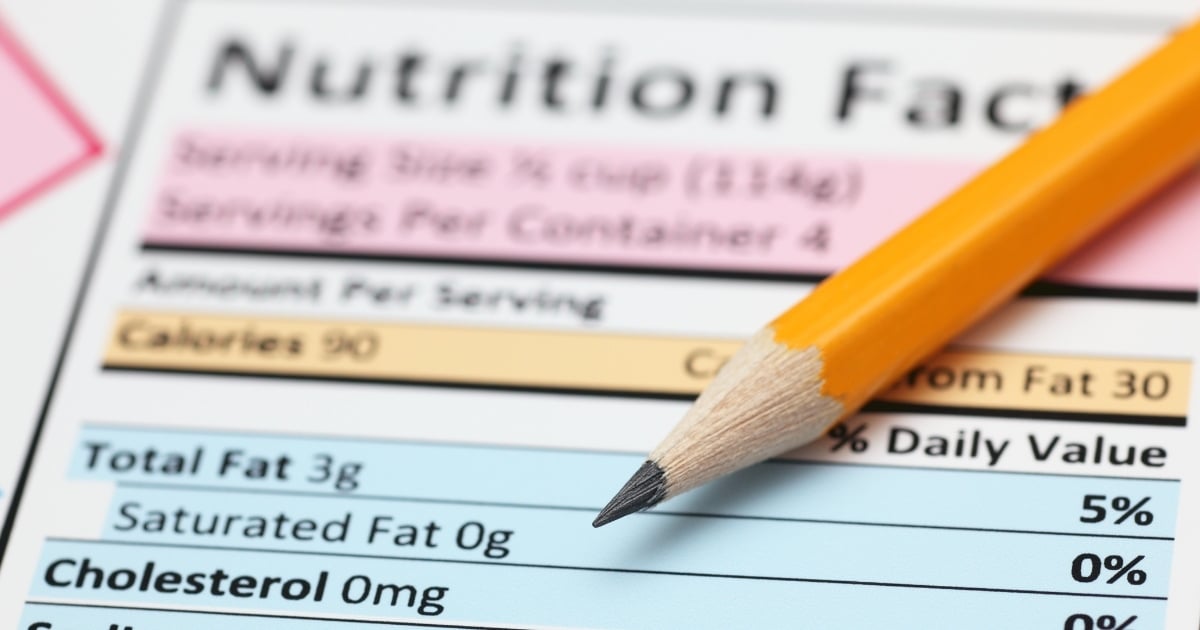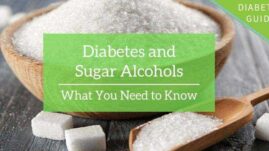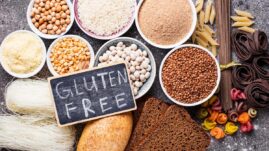Love it or hate it, the Nutrition Facts label is a tool that can help you meet your health and nutrition goals.
Learning how to read a nutrition label will give you a better understanding of what is in the food that you’re buying (and eating), as well as how to fit that into your eating plan.
If you’re counting carbs, watching your weight, reducing sodium, avoiding allergens, or looking to limit certain additives, it’s worth spending a little time at the grocery store so that you can make quick, informed decisions about the food you eat.
This article will focus on how to decipher the key parts of the Nutrition Facts label, assess if a particular food aligns with your dietary needs or health goals, and compare similar products, such as different brands of cereals or yogurt, to determine which is the best choice for you.

Understanding and using the Nutrition Facts label
In 2016, the FDA updated requirements for the Nutrition Facts label on packaged foods and drinks.
This was the first major update to the label in more than 20 years. The new labeling requirements were fully phased in by January 1, 2020, for large manufacturers, and by January 1, 2021, for small manufacturers.
This update was to provide consumers with clearer, more accurate information about the nutritional content of foods.
The new label reflects newer scientific evidence and dietary recommendations, and better meets the needs of consumers, enabling them to make healthier food choices. You might also notice that the label is a little easier to read. Let’s take a closer look.
Serving size
First things first: Start with the serving size. While there’s a lot to look at on a food label, it won’t be accurate unless you look at the serving size.
The serving size appears in a bigger, bolder font so that it’s easier to find. More importantly, perhaps, the serving sizes of some foods have been updated to reflect the amount that people usually eat. It is not a recommendation of how much to eat or drink.
Why is serving size important? All of the nutrition information on the label is based on the listed serving size. So, if you consume double the serving size, you’re also doubling your intake of calories, carbohydrates, fats, and so on, which may or may not fit with your nutrition goals.
Something else to remember is that serving size is not the same as portion size. The serving size is listed on the Nutrition Facts label, and that’s set by the FDA.
A portion size, however, is the amount of a food or drink that you actually eat. Portion sizes can be influenced by various factors, including plate size, serving utensils, and social and environmental factors.
You might also notice that right under the Nutrition Facts title, the number of servings per container is listed.
If, for example, the label states that there are 8 servings per container and you eat the entire container, you’ll have eaten eight times the amount of calories, carbs, fat, sodium, etc., that’s shown on the label.
Calories
Calories are a measure of how much energy you get from a serving of a food. Note that the number of calories is in a large and bold font on the label so that it’s easy to see.
The FDA uses 2,000 calories a day as a general guide on nutrition labels. But realize that your calorie needs may be higher or lower, depending on factors such as your age, sex, height, weight, and level of physical activity.
Learn more in: How to Find Your Daily Calorie Need.
Knowing the calorie count of a food is helpful, but you don’t necessarily need to count calories. Focusing on portion control is usually easier (and less tedious) than counting calories. Also, consider more than just the calorie content of a particular food: Look at the bigger picture.
For example, the serving size for extra-virgin olive oil is one tablespoon. The calories are roughly 120 and the total fat is roughly 14 grams, which is on the high side. However, most of the fat in olive oil is a healthy, unsaturated fat that helps support heart health.
Nutrients
Macronutrients are nutrients that the body needs in large amounts to provide energy. Fat, carbohydrates, and protein are the three macronutrients that we need for overall health. All macronutrients provide calories and are measured in grams. Here’s an overview of the macronutrients on a food label.
Total fat
“Total fat” on the label refers to all the types of fat present in a particular food. This includes saturated fat, monounsaturated fat, polyunsaturated fat, and trans fat.
Here are some tips for using the fat information on a label:
- The goal is not to necessarily choose fat-free foods, as some fat is essential for health.
- Aim to limit the amount of saturated fat in your diet. Saturated fat is found in meats, poultry, whole-milk dairy foods, and some vegetable oils, such as coconut and palm oil. This type of fat is linked with a higher risk of heart disease.
- A low-saturated-fat food, by definition, contains no more than 1 gram of saturated fat per serving.
- Try to avoid foods that contain trans fat, a type of manufactured fat, that is linked with causing heart disease and stroke.
Total carbohydrate
Of interest to many people with and without diabetes alike is the amount of carbohydrates in a particular food.
Total carbohydrate includes sugar, starch, fiber, and sugar alcohols. Sugars and starches have the most impact on blood sugar levels, whereas fiber has less of an effect. Sugar alcohols are sweeteners that have about half of the calories as regular sugar and are often found in “sugar-free” or “no-sugar-added” foods.
The Nutrition Facts label must indicate the amount of added sugar in the product. This helps to distinguish between naturally occurring sugar and sugar that is added during processing.
Here are some tips for using total carbohydrate information on a label:
- If you are counting carbohydrates, look at the total carbohydrate in grams.
- For diabetes meal planning, one serving of a carbohydrate food is often considered to contain 15 grams of carbohydrates.
- Dietary fiber, total sugars, and sugar alcohols are included in the total carbohydrate amount.
- Added sugars may include cane sugar, brown sugar, raw sugar, sucrose, dextrose, honey, or high-fructose corn syrup.
Protein
Depending on your nutrition and health goals, you may be aiming to increase or possibly decrease your protein intake. Protein plays many important roles in the body, including building and repairing muscle.
Here are some tips for using protein information on a label:
- One ounce of cooked meat, poultry, or seafood typically provides 7 grams of protein. One large egg also has about 7 grams of protein.
- Plant-based foods contain protein, too. Whole grains, legumes, soy foods, nuts, and seeds all contain protein, as well as healthy fats, fiber, and vitamins and minerals.
Percent daily value
The Percent Daily Value (%DV) indicates the contribution of a nutrient from one serving of food to your overall daily diet. As a general guide:
- 5 percent DV or less of a nutrient per serving is considered “low.”
- 10 percent DV or more is considered a “good source.”
- 20 percent DV or more of a nutrient per serving is considered “high” or an “excellent source of.”
Tips for using %DV on a label:
- Use %DV to make comparisons between different foods. Choose foods that contain more of the nutrients you want more of, such as fiber or vitamin D, and less of nutrients you want to limit, such as sodium or saturated fat.
- Foods to choose more often are those that are higher in fiber, vitamins, and minerals, and lower in saturated fat, sodium, and added sugars.
- Protein generally does not have a %DV listed on the label, so use the number of grams as a guide.
- Meet with a registered dietitian nutritionist (RD/RDN) if you are uncertain about your own nutrient goals.
Ingredients
Knowing the ingredients in a food may be important to you, especially if you have a food allergy or intolerance, or if you are aiming to choose foods with fewer additives and preservatives.
The ingredients in packaged foods and drinks are listed separately from (and usually below) the Nutrition Facts label. Each ingredient is listed in descending order by weight. This means that the ingredient that weighs the most is listed first.
Here are some tips for reading an ingredient list:
- Become familiar with common ingredients and scan the list for those that you need to avoid.
- Realize that some ingredients go by other names. For example, sodium goes by salt, baking soda, baking powder, sodium nitrite, and monosodium glutamate. Sugar goes by corn syrup, dextrose, maltose, honey, molasses, and agave nectar.
- Ingredients with names that are hard to pronounce may seem to be unhealthy or even harmful. But keep in mind that vitamins and minerals can appear on an ingredient list with their chemical name. For example, vitamin C is ascorbic acid, vitamin E is tocopheryl acetate, and iron is ferrous sulfate.
- When choosing a whole-grain food, a whole grain, such as “whole wheat,” “whole-grain brown rice,” or “whole barley” should be the first ingredient on the list.
Allergen warnings
For people with food allergies, vigilance is key. Ingredient lists and allergen warnings are essential for identifying potential allergens.
Watch for alerts like “Contains peanuts” or “Manufactured in a facility that processes tree nuts.” Common allergens such as peanuts, tree nuts, dairy, and gluten are often highlighted, but always check the full ingredient list for safety.
Recognizing these can be as important as nutritional content, especially for safeguarding against allergic reactions.
For more detailed information on navigating food allergies, consider consulting resources from reputable organizations such as the Food Allergy Research & Education (FARE) website or the American Academy of Allergy, Asthma & Immunology (AAAAI).
Nutrition terms
The FDA has rules that define the terms that food companies can use on their packages. Here are a few of the terms, as listed by the Academy of Nutrition and Dietetics:
- Low calorie: 40 calories or less per serving.
- Reduced: At least 25 percent less of the specified nutrient or calories than the usual product.
- Good source of: Provides at least 10 percent to 19 percent of the Daily Value of a particular vitamin or nutrient per serving.
- Excellent source of: Provides at least 20 percent or more of the Daily Value of a particular vitamin or nutrient per serving.
- High in: Provides 20 percent or more of the Daily Value of a specified nutrient per serving.
- Fat-free/sugar-free: Less than 1/2 gram of fat or sugar per serving.
- Low sodium: 140 milligrams or less of sodium per serving.
- Sugar-free: Less than 1/2 gram of sugar and no ingredient that is a sugar.
Net carbs
You may see the term “net carbs” on a food package. Net carbs are determined by subtracting fiber or sugar alcohols listed on the label from the total carbohydrates.
The assumption is that fiber and sugar alcohols are not absorbed or metabolized, says the American Diabetes Association (ADA), but this is not always the case. Some of these carbs are partially digested and may contribute both calories and carbs and may affect blood sugar.
The term “net carbs” does not have a legal definition and it is not used by the FDA or recognized by the ADA.
Let’s compare
Once you get the hang of reading a Nutrition Facts label and an ingredient list, you can make better choices at the grocery store. To illustrate this, we’ll compare two different strawberry yogurts manufactured by Danone.
| Dannon Light + Fat Greek Strawberry Yogurt | Oikos Triple Zero, Strawberry Flavored | |
| Serving size | 5.3 ounces (150 grams) | 5.3 ounces (150 grams) |
| Calories | 80 | 90 |
| Total fat | 0 grams (g) | 0 g |
| Sodium | 45 milligrams (mg) | 55 mg |
| Total carbohydrate | 8 g | 7 g |
| Dietary fiber | 0 g | 0 g |
| Total sugars | 6 g | 5 g |
| Added sugars | 1 g | 0 |
| Protein | 12 g | 15 g |
| Vitamin D | 0 micrograms (mcg) | 2 mcg |
| Calcium | 140 mg | 150 mg |
| Potassium | 150 mg | 150 mg |
| Ingredients include | Non-fat milk, water, strawberries, black carrot juice, carmine, modified food starch, acesulfame potassium, sucralose, fructose, active yogurt cultures | Non-fat milk, water, tapioca starch, natural flavors, vegetable juice, stevia leaf extract, lemon juice concentrate, vitamin D3, yogurt cultures |
At first glance, you might be thinking that there isn’t a big difference, nutrient-wise, between these two yogurts, and you’d be correct. And while either yogurt could be a good choice for you, there are some subtle differences that can help you make a decision:
- The Oikos yogurt is slightly lower in carbohydrates and higher in protein than the Dannon yogurt.
- The Oikos yogurt has a little more vitamin D and calcium than the Dannon yogurt.
- The Dannon yogurt contains the non-nutritive (artificial) sweeteners acesulfame potassium and sucralose, while the Oikos yogurt contains stevia leaf extract. Stevia leaf extract may seem like a “natural” sweetener, but its ingredients are highly processed.
- If it’s strawberries you’re looking for, you’ll find at least some in the Dannon version, while the Oikos yogurt has none.
- Both yogurts contain live and active cultures, which can help to support gut health.
So, what is the best choice? It depends on your own goals and preferences. Both yogurts can fit into a healthy eating plan and provide a decent amount of protein with a fairly small amount of carbohydrates. In this example, your decision may rest on the ingredients.
Final thoughts
When reading Nutrition Facts labels and ingredient lists as you compare various food products, some options will stand out as being better choices than others.
Reading labels and ingredient lists can initially seem like a waste of time, especially if you’re in a hurry to finish your grocery shopping. However, over time, you’ll become more efficient at scanning labels and ingredients, and you’ll be more confident in making choices that are aligned with your health goals.




